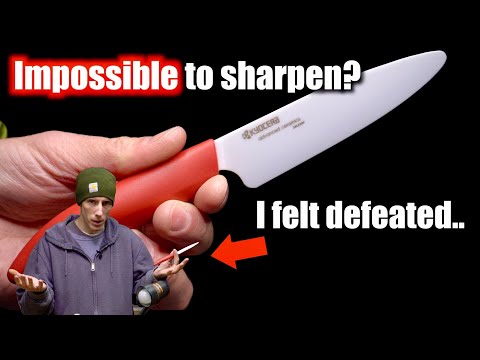
c7b8ba7227f6e76b38b17a449d2583b6
Ceramic knives are becoming increasingly popular due to their sharpness and durability. However, like any other knife, ceramic knives need to be sharpened regularly to maintain their sharpness. In this article, we will discuss the tips and techniques for sharpening ceramic knives. We will cover the different types of sharpeners available, the best sharpening techniques, and the safety precautions to take when sharpening ceramic knives. With the right tools and techniques, you can keep your ceramic knives sharp and ready for use.
How do I sharpen ceramic knives
Ceramic knives are a popular choice for many home cooks due to their sharpness and durability. However, like any knife, they will eventually need to be sharpened. Sharpening ceramic knives is a bit different than sharpening traditional steel knives, so it’s important to know the proper technique.
Steps for Sharpening Ceramic Knives
1. Gather the right tools. You will need a diamond sharpening rod, a honing steel, and a sharpening stone. The diamond sharpening rod is the most important tool, as it is specifically designed for sharpening ceramic knives.
2. Prepare the sharpening rod. Before you begin sharpening, you will need to prepare the sharpening rod. Start by cleaning the rod with a damp cloth to remove any dirt or debris. Then, apply a light coating of oil to the rod. This will help to keep the rod from becoming too hot during the sharpening process.
3. Sharpen the knife. Hold the knife at a 20-degree angle against the sharpening rod. Apply light pressure and move the knife in a circular motion along the length of the rod. Do this for about 10-15 strokes on each side of the blade.
4. Hone the knife. After sharpening, you will need to hone the knife. This will help to remove any burrs or imperfections that may have been created during the sharpening process. To hone the knife, use a honing steel. Hold the honing steel at a 20-degree angle and move the knife in a circular motion along the length of the steel. Do this for about 10-15 strokes on each side of the blade.
5. Test the knife. Once you have finished sharpening and honing the knife, it’s time to test it. Cut a piece of paper with the knife to see if it is sharp enough. If it is not, repeat the sharpening and honing process until you are satisfied with the results.
Sharpening ceramic knives is a bit different than sharpening traditional steel knives, but with the right tools and technique, it can be done easily and effectively. With regular sharpening and honing, your ceramic knives will stay sharp and ready to use for years to come.
Is there a knife sharpener for ceramic knives
Ceramic knives are becoming increasingly popular due to their sharpness and durability. But, like any other knife, they will eventually become dull and need to be sharpened. So, is there a knife sharpener for ceramic knives?
The answer is yes. Ceramic knife sharpeners are specifically designed to sharpen ceramic knives. They are usually made of diamond-coated steel and are designed to sharpen the blade without damaging the ceramic material. They are also usually small and portable, making them easy to store and use.
When using a ceramic knife sharpener, it is important to follow the instructions carefully.
This will ensure that the blade is sharpened correctly and that the ceramic material is not damaged. It is also important to use the sharpener regularly to keep the blade sharp and in good condition.
Ceramic knife sharpeners are a great way to keep your ceramic knives sharp and in good condition. They are easy to use and can help to extend the life of your ceramic knives. So, if you have ceramic knives, it is worth investing in a ceramic knife sharpener.
Are ceramic knives easy to sharpen
Ceramic knives are becoming increasingly popular due to their sharpness and durability. But one of the most common questions people have about ceramic knives is whether they are easy to sharpen. The answer is yes, but there are some important things to consider.
Ceramic knives are made from a very hard material, so they can hold an edge for a long time. This means that they don’t need to be sharpened as often as other types of knives. However, when it comes time to sharpen them, it is important to use the right tools. Ceramic knives should only be sharpened with diamond-coated sharpening stones or diamond-coated sharpening rods.
Sharpening ceramic knives is a bit different than sharpening other types of knives. It is important to use light pressure and to sharpen the blade at a very low angle. This will help to ensure that the blade is sharpened evenly and that the edge is not damaged. It is also important to use a lubricant, such as oil or water, to help reduce friction and heat.
It is also important to note that ceramic knives should not be sharpened too often. Over-sharpening can cause the blade to become brittle and can lead to chipping or cracking. It is best to sharpen the blade only when it is necessary.
In conclusion, ceramic knives are easy to sharpen, but it is important to use the right tools and techniques. It is also important to not over-sharpen the blade, as this can cause damage. With the right tools and techniques, ceramic knives can be kept sharp and ready to use for a long time.
What not to do with a ceramic knife
Ceramic knives are becoming increasingly popular due to their sharpness and durability. However, there are some things you should avoid when using a ceramic knife. Here are some tips on what not to do with a ceramic knife.
Don’t Use on Hard Surfaces
Ceramic knives are very sharp and can easily cut through soft materials like fruits and vegetables. However, they should not be used on hard surfaces like bones, frozen foods, or hard cheeses. Doing so can cause the blade to chip or break.
Don’t Drop the Knife
Ceramic knives are very fragile and can easily break if dropped. Therefore, it is important to handle the knife with care and avoid dropping it. If the knife is dropped, inspect it for any chips or cracks before using it.
Don’t Put in the Dishwasher
Ceramic knives should not be put in the dishwasher. The high temperatures and harsh detergents can damage the blade and cause it to chip or break. Instead, hand wash the knife with warm, soapy water and dry it immediately.
Don’t Use for Prying
Ceramic knives should not be used for prying or levering. Doing so can cause the blade to chip or break. Instead, use a metal knife or other tool for prying.
Don’t Store in a Drawer
Ceramic knives should not be stored in a drawer with other utensils. Doing so can cause the blade to chip or break if it comes into contact with other utensils. Instead, store the knife in a knife block or on a magnetic strip.
Conclusion
Ceramic knives are a great tool for cutting soft materials like fruits and vegetables. However, it is important to avoid using them on hard surfaces, dropping them, putting them in the dishwasher, using them for prying, and storing them in a drawer. Following these tips will help ensure that your ceramic knife stays sharp and in good condition.
We hope this article has been helpful in teaching you the tips and techniques for sharpening ceramic knives. We wish you the best of luck in your sharpening endeavors! Goodbye and take care!














